The Colorful World of Finger Painting for Kids: It’s More than Just a Mess!
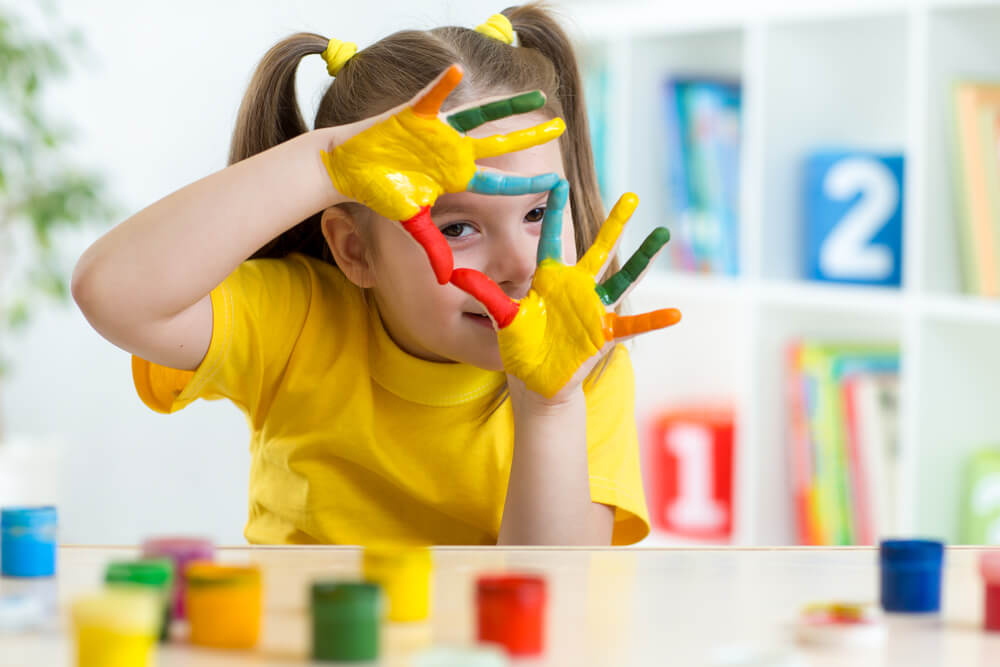
Finger painting isn’t just a way to while away an afternoon—it’s a staple of childhood exploration that babies and toddlers practically have a right to experience. Just picture it: little ones, with fingers wiggling like curious caterpillars, smearing bright globs of paint across paper, reveling in the squishy sensation and the burst of hues.
But there’s more to this squishy fun than meets the eye. Finger painting is like a play-date for the senses and the brain, all rolled into one messy, joyous package. It’s not only a chance for kids to express their budding creativity, but it’s also a silent teacher of coordination and cognitive skills.
In our post, we’re going to get down and dirty with finger painting.
Contents:
- What is Finger Painting and Why is it Good for Child Development?
- What is Needed for Finger Painting?
- How Do You Use Finger Paint for Kids? Techniques and Methods
- Homemade Finger Paint Recipes
- Cleaning, Drying, and Displaying the Finger Paintings
- FAQs
What is Finger Painting and Why is it Good for Child Development?

Pressmaster/Shutterstock.com
Finger painting is a hands-on art activity where children use their fingers (or hands) as brushes. It’s more than just getting messy; it’s a way for kids to explore the world of colors, textures, and creativity in a safe, tactile way.
This sensory-rich experience isn’t only fun; it’s integral to child development.
When children engage in finger painting, they improve their fine motor skills, hand-eye coordination, and the ability to express themselves visually, all while having a blast with colors and shapes.
What Age Should You Start Finger Painting?
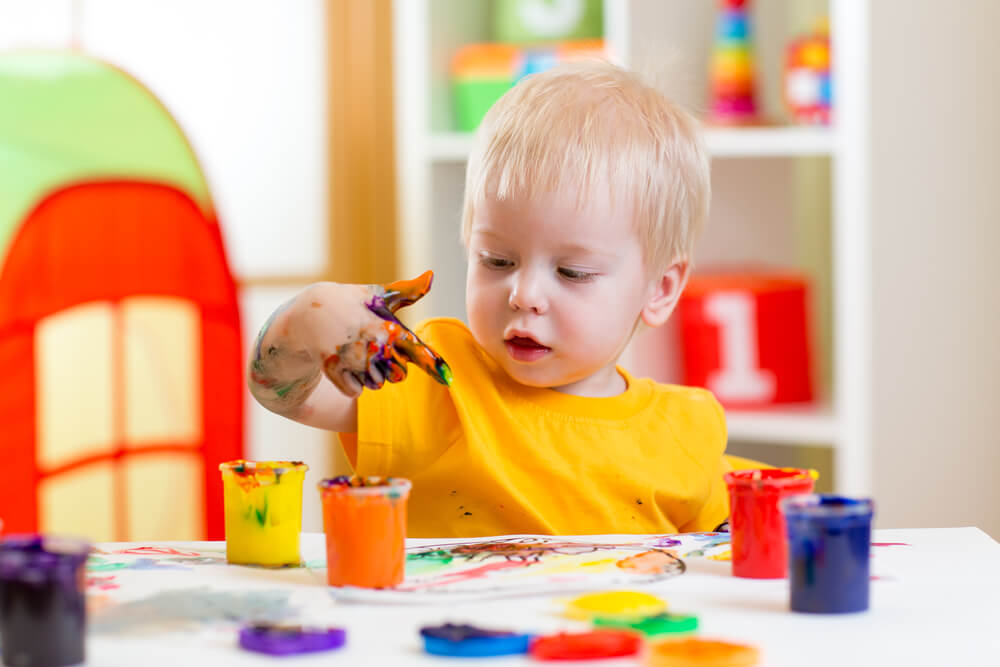
Oksana Kuzmina/Shutterstock.com
Introducing your child to the world of art can be a delightful and educational experience, and finger painting is one of the best ways to kickstart this adventure.
Recommended for a baby or child as young as a year old, finger painting is not only a fun activity but also a significant developmental milestone for toddlers. At this tender age, they are highly exploratory and utilize all their senses to understand the world around them.
Finger painting caters to this exploratory phase brilliantly, allowing toddlers to feel the paint’s texture, see the bright colors blend and transform, and even witness the reactions from their tactile movements.
There is no right or wrong way to finger paint, making this an incredibly freeing activity that celebrates the process over the final product. It’s also a fine motor skill developer, as manipulating the paint with fingers and the thumb can strengthen muscles necessary for more precise tasks later on.
Not to mention, this activity is a fantastic sensory play that encourages the development of hand-eye coordination and cognitive abilities by prompting little ones to think about actions and consequences (“What happens when I mix blue and yellow?”).
For parents, it offers a precious bonding experience and endless opportunities to teach vocabulary related to colors, actions, and sensations.
While some toddlers might take to finger painting immediately, others may need multiple interactions before they start to feel comfortable with the sensation of paint on their fingers. Do your best to introduce finger painting as a low-pressure and recurrent play activity.
What is Needed for Finger Painting?
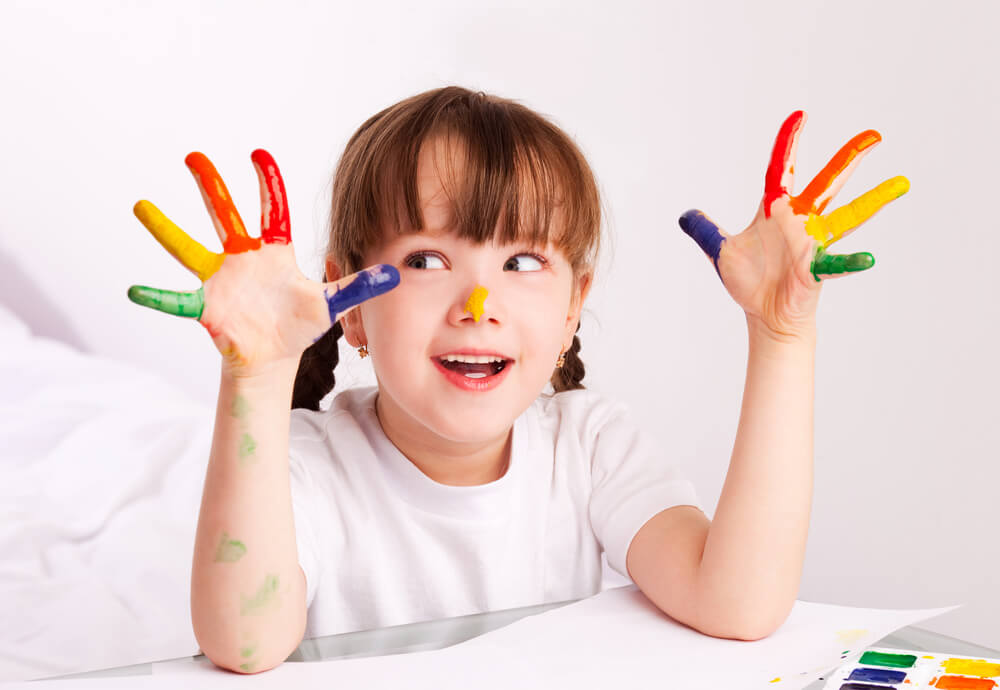
photolin/Shutterstock.com
Finger painting is not just an artsy activity; it’s a tactile adventure that unleashes creativity for individuals of all ages, especially the young ones. All you genuinely need is washable finger paint which comes in a variety of vibrant hues to captivate the attention and stir the imagination. Look for non-toxic, water-based paints for safety, especially with kids involved.
Next, you need a sturdy surface for expression—heavy-weight paper or canvas works wonderfully to absorb the paint and display your child’s great masterpieces. For those tiny hands that wander, a spacious, clutter-free area is essential to explore their artistic impulses freely.
The practical aspect of tidiness cannot be overlooked when it comes to finger painting with exuberant little artists. Laying down a washable plastic sheet or an old tablecloth can protect your floor and make cleanup a breeze. Slip on an art smock or old clothes destined for messy play to shield your child’s attire because creativity can be messy—and that’s perfectly okay.
Finally, don’t forget to have a wet cloth or a small basin of soapy water on hand for a quick clean-up of hands before the colorful evidence ends up elsewhere. With these preparations in place, the set-up for finger painting becomes a joyful and enriching experience that’s as much about the process as it is about the outcome.
Keep your little artist safe and secure with a Pingo GPS watch! Ensure they’re always within reach with Pingo’s reliable tracking features. Plus, enjoy the added bonus of a Findmykids license as a gift. Invest in their safety and creativity today!
How Do You Use Finger Paint for Kids? Techniques and Methods
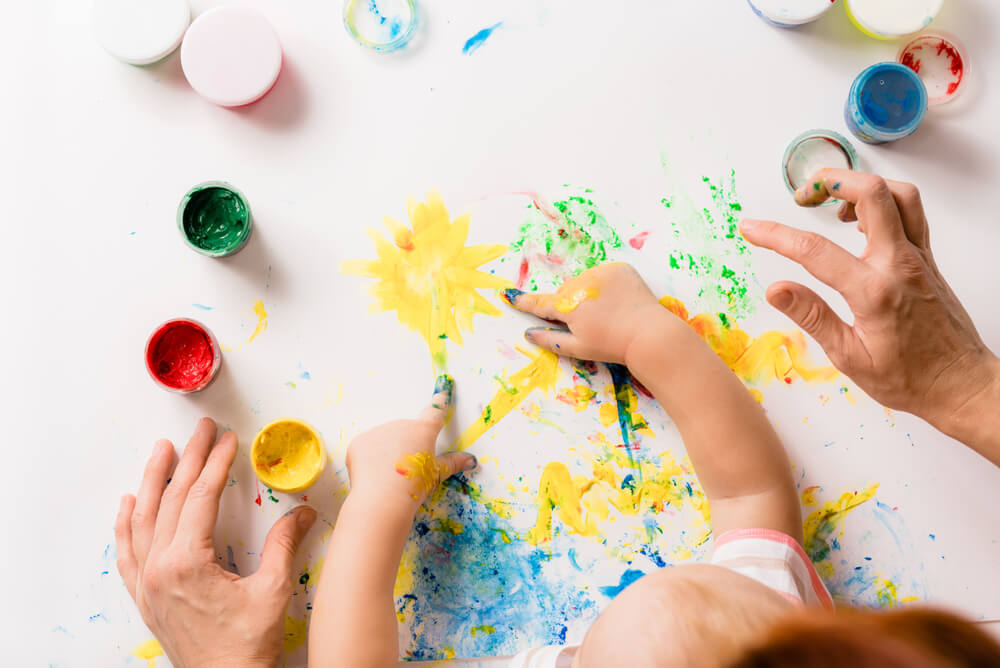
Alexander Gorban/Shutterstock.com
Finger painting is one of the most intuitive and sensory-rich art activities for kids.
The materials you need to start are quite straightforward—high-quality, washable finger paints that ensure easy cleanup, sturdy paper suitable for holding the paint, and a dedicated space that embraces creativity and possible spills.
When setting up the space for toddlers and younger preschoolers (as well as those in kindergarten), it’s crucial to consider the cleanup afterwards. Laying down a washable plastic sheet can act as a safeguard for your flooring, catching stray splashes and smudges with ease.
Another thing to have on hand? An oversized tee shirt. Protecting your child’s clothing with an art smock or old oversized t-shirt can also alleviate the stress of ruining their everyday wear. Remember, the focus is on the process, not the mess, so plan ahead of time to alleviate any of these concerns.
Finger Painting Ideas
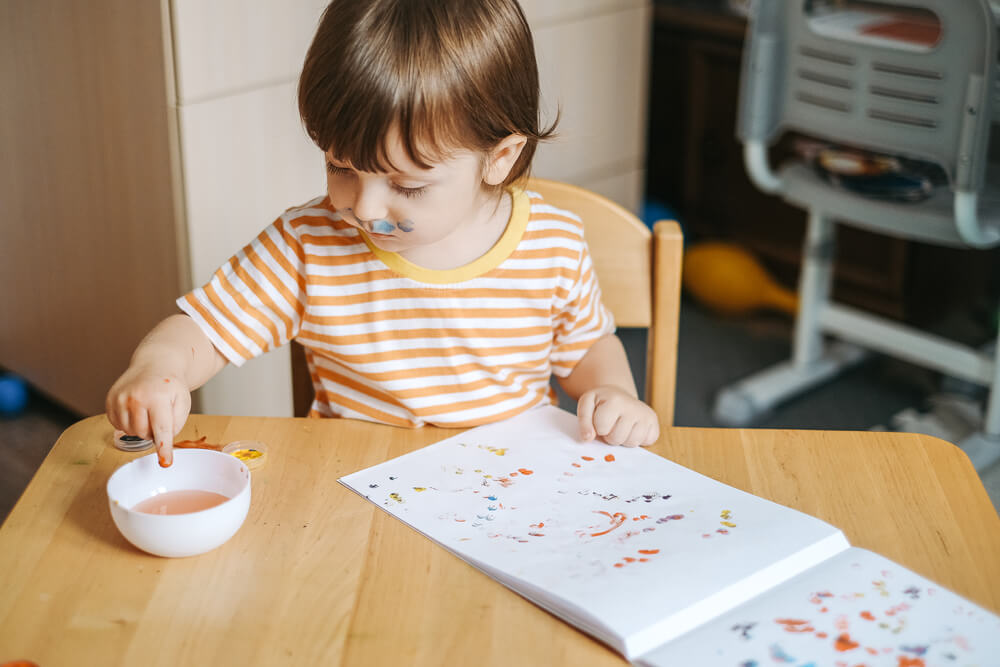
how to finger paint/Shutterstock.com
Finger painting can take many forms—it’s a way for children to learn about the world around them too. Here are some ideas to spark their creativity.
Sensory Stories
Accompany painting with stories and encourage them to paint images from the story, helping them to conceptualize events and emotions.
Here are a few ideas:
- Themed storytelling sessions: Choose a book or a story with a distinct theme, such as a jungle adventure or a beach holiday. After reading the story, ask the children to use their fingers to paint scenes or objects related to the theme. This not only helps them with comprehension but also encourages them to express the story through their unique art.
- Character creations: When telling a story, pause to introduce detailed descriptions of characters. Invite the children to paint what they think the characters look like based on the description. This activity strengthens listening skills and imagination.
- Interactive storyboards: Create a storyboard with empty spaces for scenes. Have the children paint in the different scenes as you tell the story. This not only brings the story to life but allows children to be active participants in the storytelling process.
- Textured tales: Introduce different textures into the story, such as the roughness of a dragon’s scales or the softness of a cloud. Provide materials like sand or cotton wool that can be included in the finger painting to represent these textures. Such tactile involvement enhances sensory stimulation.
Free Form Exploration
Free-form finger painting is about letting go and allowing the child’s instincts to guide the process. Children dip their fingers or their whole hands into colors, transferring their impulses directly onto paper in a pure expression of emotion and creativity. No need to get any fancier than that!
Learning Concepts with Paint
Use finger painting to solidify learning about colors, shapes, and numbers.
- Color mixology: Teach children about color theory by mixing primary colors with their fingers to create secondary colors.
- Shape tracing: Before painting, draw shapes on paper and have kids fill in the shapes with their fingers, practicing their knowledge of geometry.
Seasonal Handprint Art Ideas
Creating handprint art leaves a personal stamp, literally, on the artwork. You can use colors and themes that represent different seasons or holidays to connect the activity to their world.
Pressing the entire hand into the paint and then onto the paper results in a bold and unique masterpiece, which can be kept as a keepsake or developed into a thematic project—such as making trees, animals, or even a family tree.
Some festive ideas:
- Holiday seasons: Finger paint symbols associated with various holidays like pumpkins for Halloween or trees for Christmas.
- Weather patterns: Discuss different types of weather and have kids depict them with paintings of sunny skies, stormy clouds, or rainbow-filled afternoons.
Collaborative Projects
Why not turn it into a group activity? Collaborative pieces where each child adds to a communal canvas can foster teamwork and communication.
You can even add a bit of education into the art activity:
- Letter learning: Finger-paint letters of the alphabet and encourage children to trace over them with their own painted fingers.
- Name art: Help children spell out their names by finger painting, decorating each letter uniquely to express their individuality.
Nature-Inspired Finger Painting
Engage with the natural world by incorporating outdoor elements into finger painting.
- Leaf impressions: Press leaves into paint and stamp them onto the paper to create a forest or a garden setting.
- Fingerprint animals: Guide children to use their fingerprints to create animals, and then add details like stripes or spots with paintbrushes or markers.
Finger Painting Games
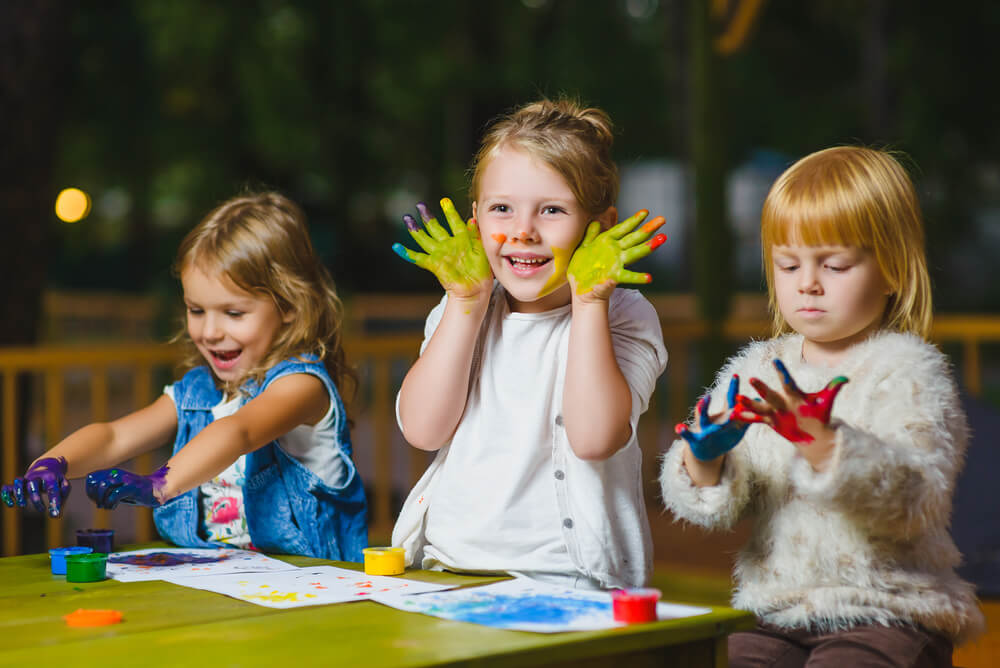
Dreams Come True/Shutterstock.com
Turn painting into a game to keep your kids engaged and excited.
- Finger paint twister: Create a grid on a large canvas and assign different colors to rows. Call out instructions like “left index finger, green” and have the kids place their fingers accordingly.
- Paint by numbers: Utilize a simple paint-by-numbers approach where children apply paint with their fingers instead of brushes, reinforcing number recognition and fine motor skills.
Texture Play
Introduce different textures into the mix by using items like sponges, cotton balls, or leaves. Dip these in paint and see what new patterns they can create.
Homemade Finger Paint Recipes
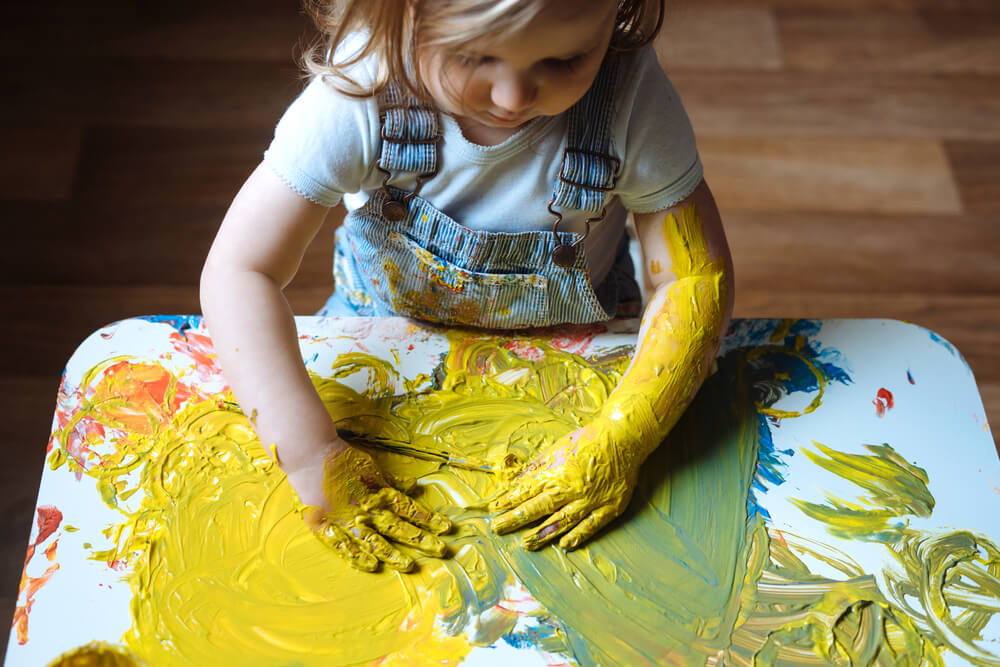
Ievgeniia Shugaliia/Shutterstock.com
If you’re feeling crafty, you can also make your own finger paint with a few simple ingredients that won’t hurt if your child decides to taste-test. Here are two quick recipes to upgrade all your crafts.
Flour-Based Paint
- Mix 1 cup of flour with 2 cups of hot water.
- Whisk until it’s a smooth paste.
- Add 2 cups of cold water and heat until boiling.
- Stir constantly while it boils and thickens.
Cornstarch Paint
- Mix 3 tablespoons of sugar with a half-cup of cornstarch.
- Add 2 cups of water and heat until boiling.
- Stir constantly while it boils and thickens.
Allow the paint to cool, then separate into containers to add food coloring. Remember, these paints may not last as long as store-bought washable paints, so use them within a week.
Cleaning, Drying, and Displaying the Finger Paintings

Davide Zanin Photography/Shutterstock.com
Cleaning up after finger painting can be as fun as the activity itself—but only if you approach it with the right attitude.
Whether you’re using wet or dry wipes, make it part of the experience and praise them for their creativity before you begin to tidy up.
For drying, simple clotheslines are perfect for hanging their art once the colors are in their proper places.
Finger Painting is Easy and Fun!
When it comes right down to it, finger painting isn’t just about the mess or the end result. It’s about the colorful, sensory experience and the joy of learning that comes with it.
By providing your child with the opportunity to finger paint, you’re giving them a valuable tool to express themselves and discover the beauty of the world, one paint-streaked finger at a time.
Remember, your involvement in your child’s finger-painting adventures is key.
Encourage without directing, join in on the fun, and help them to appreciate their works of art. Share and display their finger paintings with pride. It’s all part of fostering a love for creativity that will serve them well throughout their lives.
FAQs

Tania Kolinko/Shutterstock.com
What is the finger painting technique?
Finger painting is an art form where paint is applied to the paper by using fingers or hands, rather than brushes or other tools.
What is finger painting art?
Finger painting art includes any artwork created using paint and the artist’s fingers or hands as the primary tools of application.
Is finger painting for adults?
While finger painting is often associated with kids, it’s a relaxing and tactile way for adults to rediscover their creativity and reduce stress, too.
What is the best finger paint for kids?
The best finger paints for kids are non-toxic and washable. They come in bright, engaging colors and are easy to clean up from a variety of surfaces. Look for products designed specifically for children’s use.
The picture on the front page: Oksana Kuzmina/Shutterstock.com
Проверьте электронный ящик



















